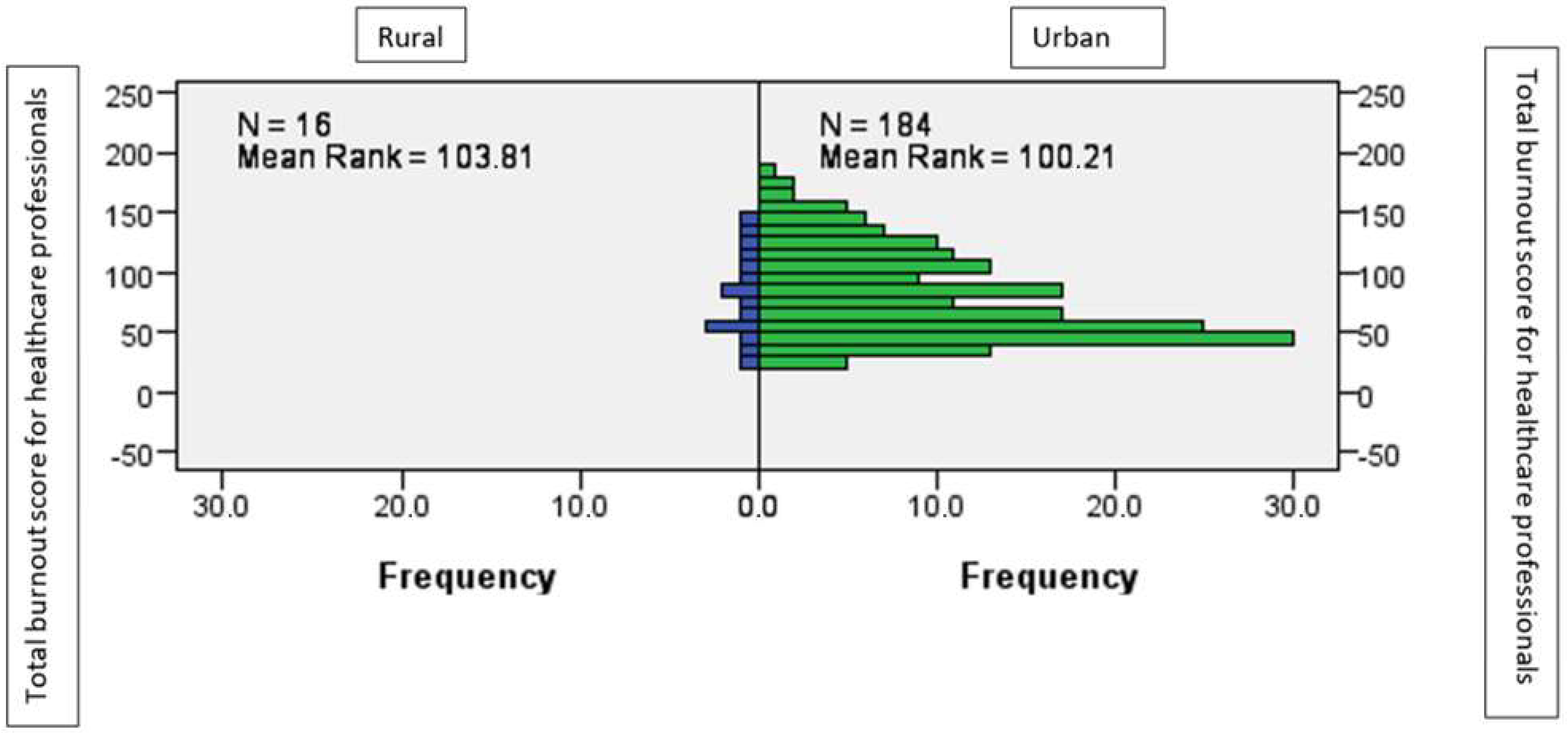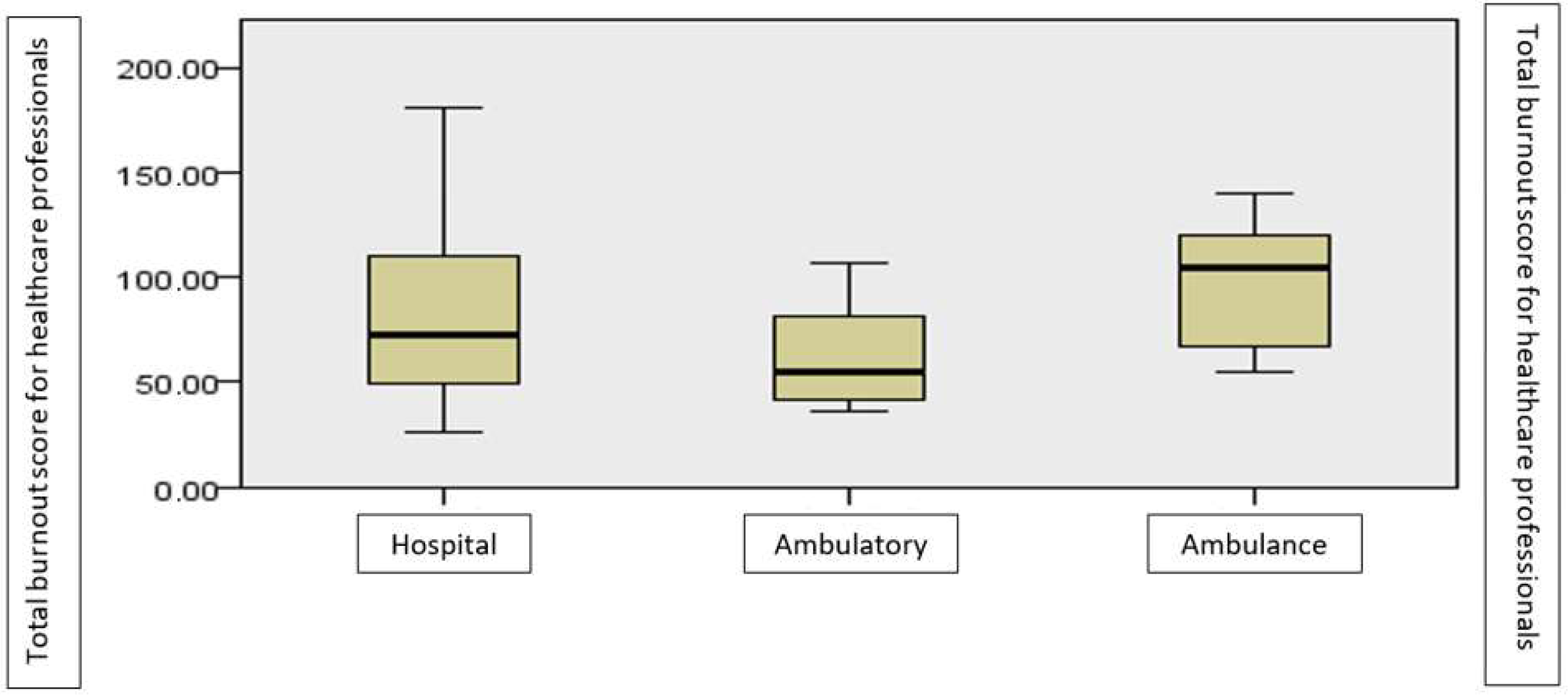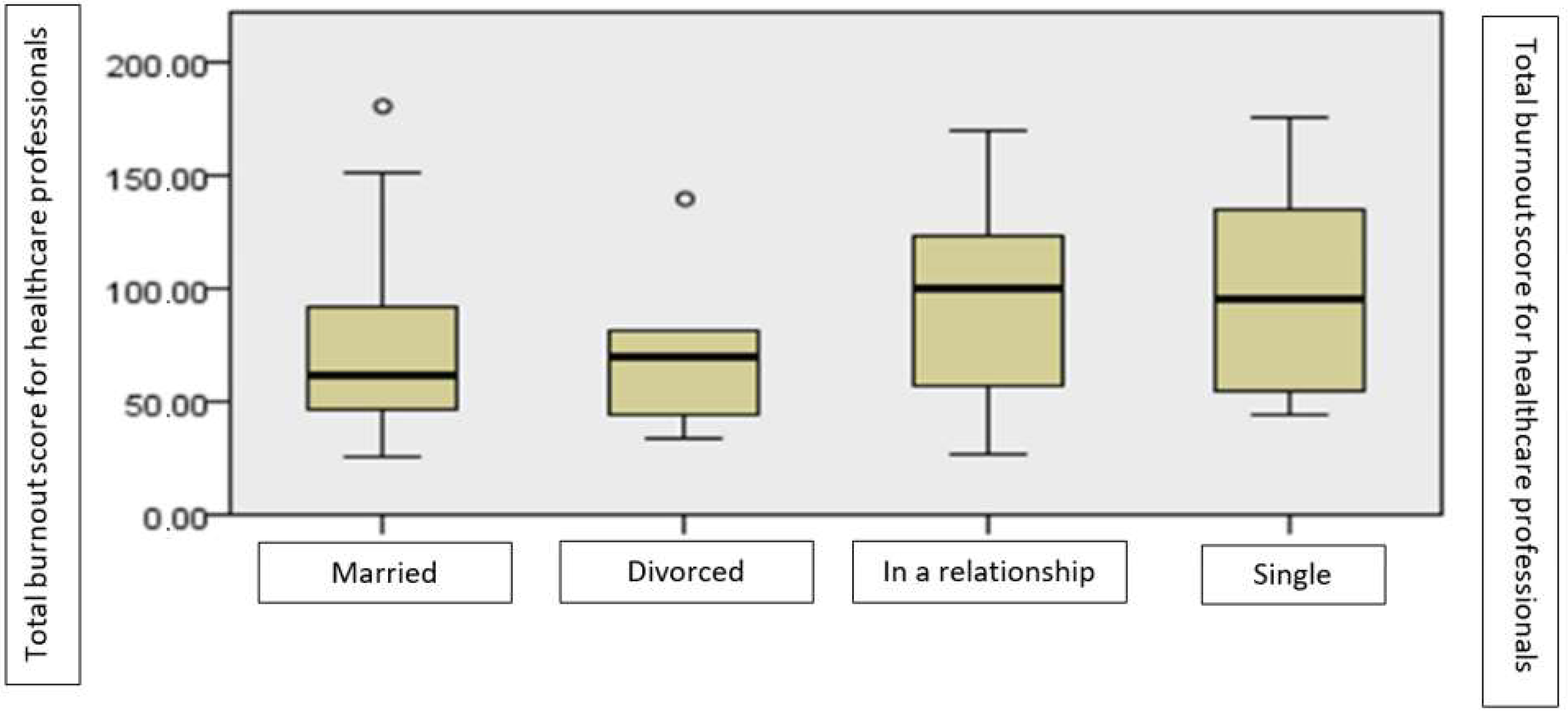Factors Associated with Burnout in Healthcare Professionals
Abstract
1. Introduction
2. Material and Methods
3. Results
3.1. Age
3.2. Gender
3.3. Workplace Location
3.4. Profession
3.5. Work Type
3.6. Workplace Seniority
3.7. Relationship Status
3.8. Persons in One’s Care
3.9. Other Factors
4. Discussion
5. Conclusions
Author Contributions
Funding
Institutional Review Board Statement
Informed Consent Statement
Conflicts of Interest
References
- Hariharan, T.S.; Griffin, B. A review of the factors related to burnout at the early-career stage of medicine. Med. Teach. 2019, 41, 1380–1391. [Google Scholar] [CrossRef] [PubMed]
- Demerouti, E. Strategies used by individuals to prevent burnout. Eur. J. Clin. Investig. 2015, 45, 1106–1112. [Google Scholar] [CrossRef] [PubMed]
- Maslach, C.; Leiter, M.P. Understanding the burnout experience: Recent research and its implications for psychiatry. World Psychiatry 2016, 15, 103–111. [Google Scholar] [CrossRef] [PubMed]
- Leiter, M.P.; Maslach, C. Burnout at Work: A Psychological Perspective; Psychology Press: London, UK, 2014; pp. 145–167. [Google Scholar]
- Hu, Q.; Schaufeli, W.B.; Taris, T.W. How are changes in exposure to job demands and job resources related to burnout and engagement? A longitudinal study among Chinese nurses and police officers. Stress Health 2017, 33, 631–644. [Google Scholar] [CrossRef] [PubMed]
- Zhou, A.Y.; Panagioti, M.; Esmail, A.; Agius, R.; Van Tongeren, M.; Bower, P. Factors Associated with Burnout and Stress in Trainee Physicians: A Systematic Review and Meta-analysis. JAMA Netw. Open 2020, 3, e2013761. [Google Scholar] [CrossRef] [PubMed]
- Dong, M.; Zhou, F.C.; Xu, S.W.; Zhang, Q.; Ng, C.H.; Ungvari, G.S.; Xiang, Y.T. Prevalence of suicide-related behaviors among physicians: A systematic review and meta-analysis. Suicide Life Threat Behav. 2020, 50, 1264–1275. [Google Scholar] [CrossRef]
- Rothenberger, D.A. Physician Burnout and Well-Being: A Systematic Review and Framework for Action. Dis. Colon. Rectum. 2017, 60, 567–576. [Google Scholar] [CrossRef]
- Boateng, G.O.; Neilands, T.B.; Frongillo, E.A.; Melgar-Quiñonez, H.R.; Young, S.L. Best Practices for Developing and Validating Scales for Health, Social, and Behavioral Research: A Primer. Front. Public Health 2018, 6, 149. [Google Scholar] [CrossRef]
- El-Menyar, A.; Ibrahim, W.H.; El Ansari, W.; Gomaa, M.; Sathian, B.; Hssain, A.A.; Wahlen, B.; Nabir, S.; Al-Thani, H. Characteristics and predictors of burnout among healthcare professionals: A cross-sectional study in two tertiary hospitals. Postgrad. Med. J. 2021, 97, 583–589. [Google Scholar] [CrossRef]
- Mitra, S.; Sarkar, A.P.; Haldar, D.; Saren, A.B.; Lo, S.; Sarkar, G.N. Correlation among perceived stress, emotional intelligence, and burnout of resident doctors in a medical college of West Bengal: A mediation analysis. Indian J. Public Health 2018, 62, 27–31. [Google Scholar]
- Escribà-Agüir, V.; Martín-Baena, D.; Pérez-Hoyos, S. Psychosocial work environment and burnout among emergency medical and nursing staff. Int. Arch. Occup. Environ. Health 2006, 80, 127–133. [Google Scholar] [CrossRef] [PubMed]
- Iorga, M.; Dascalu, N.; Soponaru, C.; Ioan, B. Burnout Syndrom among Public Ambulance Staff. Rev. Med. Chir. Soc. Med. Nat. Iasi 2015, 119, 1128–1132. [Google Scholar]
- Ashkar, K.; Romani, M.; Musharrafieh, U.; Chaaya, M. Prevalence of burnout syndrome among medical residents: Experience of a developing country. Postgrad. Med. J. 2010, 86, 266–271. [Google Scholar] [CrossRef]
- Zhang, Y.; Feng, X. The relationship between job satisfaction, burnout, and turnover intention among physicians from urban state-owned medical institutions in Hubei, China: A cross-sectional study. BMC Health Serv. Res. 2011, 11, 235. [Google Scholar] [CrossRef] [PubMed]
- Wong, A.M.F. Beyond burnout: Looking deeply into physician distress. Can. J. Ophthalmol. 2020, 55 (Suppl. S1), 7–16. [Google Scholar] [CrossRef] [PubMed]
- Bamonti, P.M.; Smith, A.; Smith, H.M. Cognitive Emotion Regulation Strategies Predict Burnout in Geriatric Nursing Staff. Clin. Gerontol. 2022, 45, 1236–1244. [Google Scholar] [CrossRef]
- Potard, C.; Landais, C. Relationships between frustration intolerance beliefs, cognitive emotion regulation strategies and burnout among geriatric nurses and care assistants. Geriatr. Nurs. 2021, 42, 700–707. [Google Scholar] [CrossRef]
- Głębocka, A. The Relationship Between Burnout Syndrome among the Medical Staff and Work Conditions in the Polish Healthcare System. Adv. Exp. Med. Biol. 2017, 968, 61–70. [Google Scholar]
- Głębocka, A. Stress and Dehumanizing Behaviors of Medical Staff Toward Patients. Adv. Exp. Med. Biol. 2019, 1133, 97–104. [Google Scholar]
- Grace, M.K.; VanHeuvelen, J.S. Occupational variation in burnout among medical staff: Evidence for the stress of higher status. Soc. Sci. Med. 2019, 232, 199–208. [Google Scholar] [CrossRef]
- Chen, Z.; Leng, J.; Pang, Y.; He, Y.; Heng, F.; Tang, L. Demographic, occupational, and societal features associated with burnout among medical oncology staff members: Cross-sectional results of a Cancer Center in Beijing, China. Psychooncology 2019, 28, 2365–2373. [Google Scholar] [CrossRef] [PubMed]
- Gosseries, O.; Demertzi, A.; Ledoux, D.; Bruno, M.A.; Vanhaudenhuyse, A.; Thibaut, A.; Laureys, S.; Schnakers, C. Burnout in healthcare workers managing chronic patients with disorders of consciousness. Brain Inj. 2012, 26, 1493–1499. [Google Scholar] [CrossRef] [PubMed]
- Jarzynkowski, P.; Piotrkowska, R.; Mędrzycka-Dąbrowska, W.; Książek, J. Areas of Work Life as Predictors of Occupational Burnout of Nurses and Doctors in Operating Theaters in Poland-Multicenter Studies. Healthcare 2021, 10, 26. [Google Scholar] [CrossRef]
- Marques, M.M.; Alves, E.; Queirós, C.; Norton, P.; Henriques, A. The effect of profession on burnout in hospital staff. Occup. Med. 2018, 68, 207–210. [Google Scholar] [CrossRef] [PubMed]
- Selmanovic, S.; Ramic, E.; Pranjic, N.; Brekalo-Lazarevic, S.; Pasic, Z.; Alic, A. Stress at work and burnout syndrome in hospital doctors. Med. Arch. 2011, 65, 221–224. [Google Scholar] [CrossRef]
- Balwi, M.K.M.; Yee, D.W.; Thukiman, K.; Haziqah, A. The Relationship between Workload and Burnout among the Medical Staff in Hospital. Sains Hum. 2021, 13, 1891. [Google Scholar]
- Chou, L.P.; Li, C.Y.; Hu, S.C. Job stress and burnout in hospital employees: Comparisons of different medical professions in a regional hospital in Taiwan. BMJ Open 2014, 4, e004185. [Google Scholar] [CrossRef]
- Messias, E.; Gathright, M.M.; Freeman, E.S.; Flynn, V.; Atkinson, T.; Thrush, C.R.; Clardy, J.A.; Thapa, P. Differences in burnout prevalence between clinical professionals and biomedical scientists in an academic medical centre: A cross-sectional survey. BMJ Open 2019, 9, e023506. [Google Scholar] [CrossRef]
- Rosenstein, A.H. Hospital administration response to physician stress and burnout. Hosp. Pract. 2019, 47, 217–220. [Google Scholar] [CrossRef]
- Okuda, Y.; Iwasaki, S.; Deguchi, Y.; Nitta, T.; Mitake, T.; Sakaguchi, A.; Niki, A.; Inoue, K. Burnout and occupational stressors among non-medical occupational health staff. Occup. Med. 2020, 70, 45–51. [Google Scholar] [CrossRef]
- Willard-Grace, R.; Hessler, D.; Rogers, E.; Dubé, K.; Bodenheimer, T.; Grumbach, K. Team structure and culture are associated with lower burnout in primary care. J. Am. Board. Fam. Med. 2014, 27, 229–238. [Google Scholar] [CrossRef]
- Gorgulu, O.; Akilli, A. The determination of the levels of burnout syndrome, organizational commitment, and job satisfaction of the health workers. Niger. J. Clin. Pract. 2017, 20, 48–56. [Google Scholar] [CrossRef]
- Ganeshan, D.; Rosenkrantz, A.B.; Bassett, R.L., Jr.; Williams, L.; Lenchik, L.; Yang, W. Burnout in Academic Radiologists in the United States. Acad. Radiol. 2020, 27, 1274–1281. [Google Scholar] [CrossRef]
- Nowacka, A.; Piskorz, A.; Wolfshaut-Wolak, R.; Piątek, J.; Gniadek, A. Selected Socio-Demographic and Occupational Factors of Burnout Syndrome in Nurses Employed in Medical Facilities in Małopolska-Preliminary Results. Int. J. Environ. Res. Public Health 2018, 15, 2083. [Google Scholar] [CrossRef]
- Kwon, C.Y.; Lee, B.; Kwon, O.J.; Kim, M.S.; Sim, K.L.; Choi, Y.H. Emotional Labor, Burnout, Medical Error, and Turnover Intention among South Korean Nursing Staff in a University Hospital Setting. Int. J. Environ. Res. Public Health 2021, 18, 10111. [Google Scholar] [CrossRef]
- Yung, M.; Du, B.; Gruber, J.; Yazdani, A. Developing a Canadian fatigue risk management standard for first responders: Defining the scope. Saf. Sci. 2021, 134, 105044. [Google Scholar] [CrossRef]
- Patel, R.S.; Bachu, R.; Adikey, A.; Malik, M.; Shah, M. Factors Related to Physician Burnout and Its Consequences: A Review. Behav Sci. 2018, 8, 98. [Google Scholar] [CrossRef]
- Zhang, X.J.; Song, Y.; Jiang, T.; Ding, N.; Shi, T.Y. Interventions to reduce burnout of physicians and nurses: An overview of systematic reviews and meta-analyses. Medicine 2020, 99, e20992. [Google Scholar] [CrossRef]
- Shields, K.; Somerville, P. In the Tiger’s Mouth: An Empowerment Guide for Social Action; New Society Publishers: Gabriola Island, BC, Canada, 1993; p. 130. [Google Scholar]
- Maslach, C.; Jackson, S.E.; Leiter, M.P. Maslach Burnout Inventory. In Evaluating Stress: A Book of Resources, 3rd ed.; Zalaquett, C.P., Wood, R.J., Eds.; Scarecrow Education: Lanham, MD, USA, 1997; pp. 191–218. [Google Scholar]
- Rössler, W. Stress, burnout, and job dissatisfaction in mental health workers. Eur. Arch. Psychiatry Clin. Neurosci. 2012, 262 (Suppl. S2), S65–S69. [Google Scholar] [CrossRef]
- Willard-Grace, R.; Knox, M.; Huang, B.; Hammer, H.; Kivlahan, C.; Grumbach, K. Burnout and Health Care Workforce Turnover. Ann. Fam. Med. 2019, 17, 36–41. [Google Scholar] [CrossRef]
- Dyrbye, L.N.; Shanafelt, T.D.; Johnson, P.O. A cross-sectional study exploring the relationship between burnout, absenteeism, and job performance among American nurses. BMC Nurs. 2019, 18, 57. [Google Scholar] [CrossRef]
- Hu, Z.; Wang, H.; Xie, J.; Zhang, J.; Li, H.; Liu, S.; Li, Q.; Yang, Y.; Huang, Y. Burnout in ICU doctors and nurses in mainland China-A national cross-sectional study. J. Crit. Care 2021, 62, 265–270. [Google Scholar] [CrossRef]
- Gunawan, J.; Aungsuroch, Y.; Fisher, M.L.; Marzilli, C.; Liu, Y. Factors Related to the Clinical Competence of Registered Nurses: Systematic Review and Meta-Analysis. J. Nurs. Sch. 2020, 52, 623–633. [Google Scholar] [CrossRef]
- Shi, L.; Li, G.; Hao, J. Psychological depletion in physicians and nurses exposed to workplace violence: A cross-sectional study using propensity score analysis. Int. J. Nurs. Stud. 2020, 103, 103493. [Google Scholar] [CrossRef]
- Sarabia-Cobo, C.; Pérez, V.; Fernández-Rodríguez, Á.; González-López, J.R.; González-Vaca, J. Burnout, Compassion Fatigue and Psychological Flexibility among Geriatric Nurses: A Multicenter Study in Spain. Int. J. Environ. Res. Public Health. 2021, 18, 7560. [Google Scholar] [CrossRef]
- Bazmi, E.; Alipour, A.; Yasamy, M.T.; Kheradmand, A.; Salehpour, S.; Khodakarim, S.; Soori, H. Job Burnout and Related Factors among Health Sector Employees. Iran J. Psychiatry 2019, 14, 309–316. [Google Scholar] [CrossRef]
- Ebrahimi, H.; Navidian, A.; Ameri, M.; Sadeghi, M. Burnout, dimensions and its related factors in the operational staff of medicine emergency. J. Health Promot. Manag. 2014, 3, 16–26. [Google Scholar]
- Simons, B.S.; Foltz, P.A.; Chalupa, R.L.; Hylden, C.M.; Dowd, T.C.; Johnson, A.E. Burnout in U.S. Military Orthopaedic Residents and Staff Physicians. Mil. Med. 2016, 181, 835–839. [Google Scholar] [CrossRef]
- Zhang, Z.; Lu, Y.; Yong, X.; Li, J.; Liu, J. Effects of Occupational Radiation Exposure on Job Stress and Job Burnout of Medical Staff in Xinjiang, China: A Cross-Sectional Study. Med. Sci. Monit. 2020, 26, e927848. [Google Scholar] [CrossRef]
- Ghazi, B.; Himd, B.; Makhdoom, Y.M.; Habadi, M.I.; Ibrahim, A. Pattern of Burnout Among Medical Interns in Jeddah. Int. Ann. Med. 2018, 2, 545. [Google Scholar]
- Nituica, C.; Bota, O.A.; Blebea, J. Factors influencing resilience and burnout among resident physicians—A National Survey. BMC Med. Educ. 2021, 21, 514. [Google Scholar] [CrossRef]
- Kansoun, Z.; Boyer, L.; Hodgkinson, M.; Villes, V.; Lancon, C.; Fond, G. Burnout in French physicians: A systematic review and Metaanalysis. J. Affect. Disord. 2019, 246, 132–147. [Google Scholar] [CrossRef]
- Shanafelt, T.D.; Hasan, O.; Dyrbye, L.N.; Sinsky, C.; Satele, D.; Sloan, J.; West, C.P. Changes in Burnout and Satisfaction With Work-Life Balance in Physicians and the General US Working Population Between 2011 and 2014. Mayo Clin. Proc. 2015, 90, 1600–1613. [Google Scholar] [CrossRef]
- Bria, M.; Băban, A.; Andreica, S.; Dumitraşcu, D.L. Burnout and Turnover Intentions among Romanian Ambulance Personnel. Procedia Soc. Behav. Sci. 2013, 84, 801–805. [Google Scholar] [CrossRef]
- Lee, R.T.; Seo, B.; Hladkyj, S.; Lovell, B.L.; Schwartzmann, L. Correlates of physician burnout across regions and specialties: A meta-analysis. Hum. Resour. Health 2013, 11, 48. [Google Scholar] [CrossRef]
- Dimitriu, M.C.T.; Pantea-Stoian, A.; Smaranda, A.C.; Nica, A.A.; Carap, A.C.; Constantin, V.D.; Davitoiu, A.M.; Cirstoveanu, C.; Bacalbasa, N.; Bratu, O.G.; et al. Burnout syndrome in Romanian medical residents in time of the COVID-19 pandemic. Med. Hypotheses 2020, 144, 109972. [Google Scholar] [CrossRef]
- Saleem, J.J.; Price, M.; Read, J.M. Provider Burnout as it relates to the Electronic Health Record and Clinical Workflow. Proc. Hum. Factors Ergon. Soc. Annu. Meet. 2020, 64, 598–602. [Google Scholar] [CrossRef]






| Total Number (Percentage) | Mean ± Standard Deviation | |
|---|---|---|
| Age | 36.09 ± 9.364 | |
| Sex | ||
| Women | 181 (90.5%) | |
| Men | 19 (9.5%) | |
| Workplace location | ||
| Rural | 16 (8%) | |
| Urban | 184 (92%) | |
| Profession | ||
| Senior doctor | 53 (26.5%) | |
| Resident doctor | 84 (42%) | |
| Nurse | 53 (26.5%) | |
| Orderly | 6 (3%) | |
| Auxiliary personnel | 4 (2%) | |
| Work type | ||
| Hospital | 176 (88%) | |
| Ambulatory | 16 (8%) | |
| Ambulance | 8 (4%) | |
| Workplace seniority | 2011.95 ± 10.112 | |
| Relationship status | 1.95 ± 1.159 | |
| Married | 113 (56.5%) | |
| Divorced | 10 (5%) | |
| In a relationship | 51 (25.5%) | |
| Single | 26 (13%) | |
| Persons in care | ||
| Children | 0.62 ± 0.8055 | |
| Seniors | 0.245 ± 0.5888 | |
| Total burnout score | ||
| Medical staff | 80.34 ± 37.24 | |
| p | r (rho) | |
|---|---|---|
| Age | <0.001 | −0.266 |
| Genetic sex | 0.292 | 1.47 |
| Workplace location | 0.811 | 1.42 |
| Profession | <0.001 | 36.734 |
| Work type | 0.037 | 6.58 |
| Workplace seniority | <0.001 | 0.29 |
| Relationship status | <0.001 | 16.14 |
| Persons in care (number) | 0.016 | −0.171 |
| Persons in care | <0.001 | −0.29 |
| Children | <0.001 | −0.293 |
| Seniors | 0.546 | −0.043 |
| p | r | |
|---|---|---|
| Total burnout level score for the medical staff | 0.01 | 1000 |
| I feel a lot of pressure from the hospital management. | 0.01 | 488 |
| It bothers me that I have to deal with the administrative side as well, not just with patients. | 0.01 | 495 |
| At work, I encounter conflict situations with my colleagues. | 0.01 | 309 |
| I am constantly afraid of making a mistake that could cost a patient’s life. | 0.01 | 328 |
| I feel the pressure of the responsibility I have towards patients all the time. | 0.01 | 326 |
| I deal more with medical documents than with patients. | 0.01 | 443 |
| I face a routine in the activities carried out at work. | 0.01 | 446 |
| I always feel that I have to do many things in a short time. | 0.01 | 375 |
| I feel regret for the decisions I made in the cases of certain patients. | 0.01 | 311 |
| I felt harassed at work. | 0.01 | 488 |
| I feel overwhelmed in certain cases and cannot react professionally. | 0.01 | 444 |
| I feel that I am not completely correct in the professional environment, having to make certain compromises. | 0.01 | 546 |
| In my free time, I always think about patients’ cases. | 0.01 | 343 |
Publisher’s Note: MDPI stays neutral with regard to jurisdictional claims in published maps and institutional affiliations. |
© 2022 by the authors. Licensee MDPI, Basel, Switzerland. This article is an open access article distributed under the terms and conditions of the Creative Commons Attribution (CC BY) license (https://creativecommons.org/licenses/by/4.0/).
Share and Cite
Taranu, S.M.; Ilie, A.C.; Turcu, A.-M.; Stefaniu, R.; Sandu, I.A.; Pislaru, A.I.; Alexa, I.D.; Sandu, C.A.; Rotaru, T.-S.; Alexa-Stratulat, T. Factors Associated with Burnout in Healthcare Professionals. Int. J. Environ. Res. Public Health 2022, 19, 14701. https://doi.org/10.3390/ijerph192214701
Taranu SM, Ilie AC, Turcu A-M, Stefaniu R, Sandu IA, Pislaru AI, Alexa ID, Sandu CA, Rotaru T-S, Alexa-Stratulat T. Factors Associated with Burnout in Healthcare Professionals. International Journal of Environmental Research and Public Health. 2022; 19(22):14701. https://doi.org/10.3390/ijerph192214701
Chicago/Turabian StyleTaranu, Sabinne Marie, Adina Carmen Ilie, Ana-Maria Turcu, Ramona Stefaniu, Ioana Alexandra Sandu, Anca Iuliana Pislaru, Ioana Dana Alexa, Calina Anda Sandu, Tudor-Stefan Rotaru, and Teodora Alexa-Stratulat. 2022. "Factors Associated with Burnout in Healthcare Professionals" International Journal of Environmental Research and Public Health 19, no. 22: 14701. https://doi.org/10.3390/ijerph192214701
APA StyleTaranu, S. M., Ilie, A. C., Turcu, A.-M., Stefaniu, R., Sandu, I. A., Pislaru, A. I., Alexa, I. D., Sandu, C. A., Rotaru, T.-S., & Alexa-Stratulat, T. (2022). Factors Associated with Burnout in Healthcare Professionals. International Journal of Environmental Research and Public Health, 19(22), 14701. https://doi.org/10.3390/ijerph192214701







